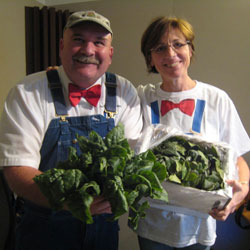On a farm, the environment under a semi-circular metal frame covered by a thin sheet of polyurethane can be an oasis on a frosty fall day. For spinach plants, the structure, known as a hoop house or a cold frame, can mean the difference between a season-ending freeze or several more months of growth.
Farmer Lee Jones of The Chef’s Garden in Huron, Ohio, relies on hoop houses to grow what he calls “ice spinach.” Jones, whose sustainable and organic farm supplies many of the city’s leading chefs, allows the spinach to freeze at night and then thaw out during the day. He explains that, in the hoop house, temperatures can reach 55 to 60 degrees during warmest parts of the day.
And unlike the head of frozen head of lettuce that got pushed back too far in the refrigerator, spinach plants have the ability to rehydrate in warmer temperatures because the taproots remain unfrozen.
“It almost looks like a savory cabbage—it’s got so much body and texture to the leaf and the deep dark green colors to it,” explains Jones, adding that the freezing process makes the spinach crunch almost like wax paper.
Jones modeled the idea of ice spinach after that of ice wine, which uses frozen grapes with higher sugar content. The concept behind ice spinach is the same: The cold temperature causes the spinach to produce more sugar, or energy, to stay alive. The result is a type of spinach that is so sweet that last winter, Jones says, some of its sugar levels tested higher than those in Red Delicious apples.
“This time of year, the spinaches and the greens really take center stage,” notes Jones, who also grows several other varieties of spinach, such as red lace spinach, purple spinach, and tropical spinach. “The cruciferous greens love the cooler temperatures. They thrive on it. Now is when they’re really at their height!”

Jones (pictured to the right with All Things Considered host Amy Eddings) is easy to recognize in passing. Just look out for the white shirt, overalls, and red bow tie. He makes a point to look the part of a farmer in order to better advocate for small family farms. Due to soaring interest rates in the late 1970s, his own family lost its farm when Jones was only 19 years old.
Fortunately, chef Jean-Louis Palladin, who used to cook at the Watergate Hotel, asked the Jones family to grow vegetables specifically for him. Now, The Chef’s Garden supplies leading chefs around the world with produce. The farm’s Culinary Vegetable Institute also works to educate chefs and foster a better understanding of the relationship between food and farm.
Tortellini with Fennel, Tomatoes, and Spinach
Recipes courtesy of The Culinary Vegetable Institute
- ¼ cup olive oil
- 6 garlic cloves, minced
- 1/8 teaspoon crushed red pepper flakes
- 1 fennel bulb, halved vertically and thinly sliced
(reserve feathery sprigs) - 2 plum tomatoes, seeded and diced
- 5 cups fresh “purple” spinach, stems discarded
- ¼ teaspoon salt
- Generous seasoning freshly ground black pepper
- 1 pound cheese tortellini
- ¼ grated Parmesan cheese
- 1 tablespoon finely chopped fennel sprigs
1. Bring a large stockpot of water to a boil.
2. Heat the oil in a large skillet over medium heat. Add the garlic and red pepper flakes and cook it 1 minute. Stir in the fennel and sauté 5 minutes, or until crisp but tender. Add the tomatoes, toss well, and cook 5 minutes, or until the tomato pieces begin to soften.
3. Stir in the spinach, salt, and pepper and toss just until wilted, about 1 minute. Keep the sauce warm over low heat.
4. Drop the tortellini into the boiling water and cook until al dente, that is, tender yet firm, about 5 minutes. Meanwhile check the consistency of the sauce. Depending on the juiciness of your tomatoes, it might need some liquid. If so, remove 2 tablespoons of the starchy pasta water and add it to the sauce. Drain the tortellini thoroughly, then mix it into the sauce along with the cheese. Serve with the chopped fennel sprigs sprinkled on top.